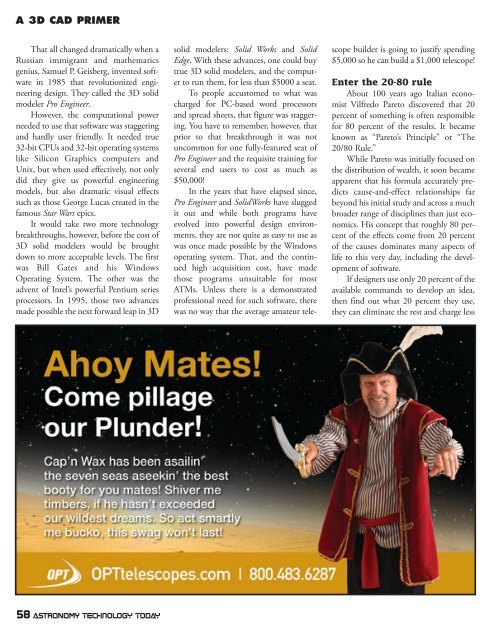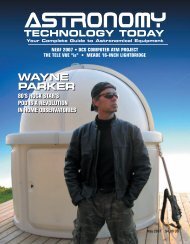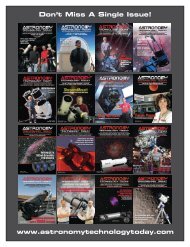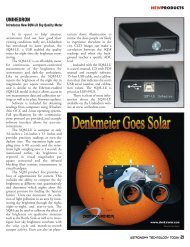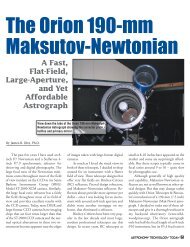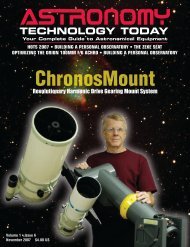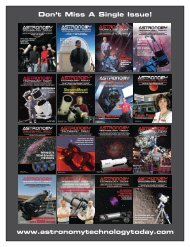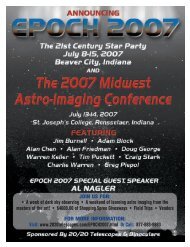magnilux - Astronomy Technology Today
magnilux - Astronomy Technology Today
magnilux - Astronomy Technology Today
You also want an ePaper? Increase the reach of your titles
YUMPU automatically turns print PDFs into web optimized ePapers that Google loves.
A 3D CAD PRIMER<br />
That all changed dramatically when a<br />
Russian immigrant and mathematics<br />
genius, Samuel P. Geisberg, invented software<br />
in 1985 that revolutionized engineering<br />
design. They called the 3D solid<br />
modeler Pro Engineer.<br />
However, the computational power<br />
needed to use that software was staggering<br />
and hardly user friendly. It needed true<br />
32-bit CPUs and 32-bit operating systems<br />
like Silicon Graphics computers and<br />
Unix, but when used effectively, not only<br />
did they give us powerful engineering<br />
models, but also dramatic visual effects<br />
such as those George Lucas created in the<br />
famous Star Wars epics.<br />
It would take two more technology<br />
breakthroughs, however, before the cost of<br />
3D solid modelers would be brought<br />
down to more acceptable levels. The first<br />
was Bill Gates and his Windows<br />
Operating System. The other was the<br />
advent of Intel’s powerful Pentium series<br />
processors. In 1995, those two advances<br />
made possible the next forward leap in 3D<br />
solid modelers: Solid Works and Solid<br />
Edge. With these advances, one could buy<br />
true 3D solid modelers, and the computer<br />
to run them, for less than $5000 a seat.<br />
To people accustomed to what was<br />
charged for PC-based word processors<br />
and spread sheets, that figure was staggering.<br />
You have to remember, however, that<br />
prior to that breakthrough it was not<br />
uncommon for one fully-featured seat of<br />
Pro Engineer and the requisite training for<br />
several end users to cost as much as<br />
$50,000!<br />
In the years that have elapsed since,<br />
Pro Engineer and SolidWorks have slugged<br />
it out and while both programs have<br />
evolved into powerful design environments,<br />
they are not quite as easy to use as<br />
was once made possible by the Windows<br />
operating system. That, and the continued<br />
high acquisition cost, have made<br />
those programs unsuitable for most<br />
ATMs. Unless there is a demonstrated<br />
professional need for such software, there<br />
was no way that the average amateur telescope<br />
builder is going to justify spending<br />
$5,000 so he can build a $1,000 telescope!<br />
Enter the 20-80 rule<br />
About 100 years ago Italian economist<br />
Vilfredo Pareto discovered that 20<br />
percent of something is often responsible<br />
for 80 percent of the results. It became<br />
known as “Pareto’s Principle” or “The<br />
20/80 Rule.”<br />
While Pareto was initially focused on<br />
the distribution of wealth, it soon became<br />
apparent that his formula accurately predicts<br />
cause-and-effect relationships far<br />
beyond his initial study and across a much<br />
broader range of disciplines than just economics.<br />
His concept that roughly 80 percent<br />
of the effects come from 20 percent<br />
of the causes dominates many aspects of<br />
life to this very day, including the development<br />
of software.<br />
If designers use only 20 percent of the<br />
available commands to develop an idea,<br />
then find out what 20 percent they use,<br />
they can eliminate the rest and charge less<br />
58 <strong>Astronomy</strong> TECHNOLOGY TODAY


